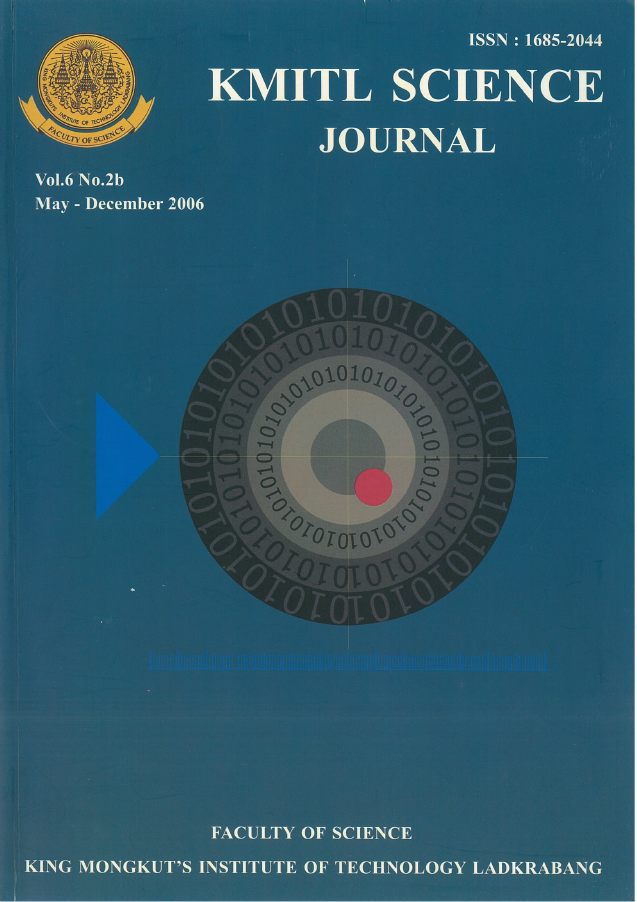Influence of Physico-Chemical Variables on Abundance of Chironomidae (Diptera) in Tropical Rice Agroecosystem
Main Article Content
Abstract
Influence of selected physico-chemical factors such as water level, rice plant height, temperature, pH, conductivity, dissolved oxygen, total organic matter, total suspended solids. Phosphate and nitrate- nitrogen on larval population of Chironomidae (Diptera) were studied in a rice field. Thses variables showed a wide range of variation over two seasons of rice cultivation studied. Water level, rice plant height, conductivity, phosphate and nitrate- nitrogen contents of the water weakly influenced the abundance of chironomid larvae in this rice field at P=0.05. However, other variables did not affect the larval population.
Keywords: Chironomidae, rice agroecosystem, physico-chemical variables, abundance
Corresponding author: E-mail: csalmah@usm.my
Article Details
Copyright Transfer Statement
The copyright of this article is transferred to Current Applied Science and Technology journal with effect if and when the article is accepted for publication. The copyright transfer covers the exclusive right to reproduce and distribute the article, including reprints, translations, photographic reproductions, electronic form (offline, online) or any other reproductions of similar nature.
The author warrants that this contribution is original and that he/she has full power to make this grant. The author signs for and accepts responsibility for releasing this material on behalf of any and all co-authors.
Here is the link for download: Copyright transfer form.pdf
References
[2] Ali, A. B. & Ahmad, M. 1988 Water Quality in Rice Field and Sump Ponds and Its Relationship to Phytoplankton Growth in Rice Field Fish Culture System, Tropical Ecology 29, 63-70.
[3] Lim, R.P., Abdullah, M.F. and Fernando, C.H. 1984 Ecological Studies of Cladocera in the Rice Fields of Tanjung Karang, Malaysia, Subjected to Pesticide Treatment. Hydrobiologia 113, 99-103.
[4] Che Salmah, M. R., Hassan, S. T. S., Abu Hassan, A. and Ali, A. B. 1998 Influence of Physical and Chemical Factors on the Larval Abundance of Neurothemis tullia (Dury) (Odonata: Libellulidae) in a Rice Field. Hydrobiologia 389, 193-202.
[5] Che Salmah, M. R., and Abu Hassan, A. 2002 Distribution of Aquatic Insects in Relation to Rice Cultivation in a Rain Fed Rice Field. Jurnal Biosains 13(1), 87-107.
[6] Armitage, P.D., Cranston, P.S. and Pinder, L.C.V. 1995 The Chironomidae: Biology and Ecology of Non-Biting Midges. Chapman and Hall, London, United Kingdom.
[7] Stevens, M.M. 1995. Biology Control of Chironomus tepperi Skuse, A Pest of Rice in New South Wales. In Cranston, P.S. Ed. Chironomids from Gene to Ecosystem. CSIRO, Australia, pp. 235-239.
[8] Fores, E. 1992 Nutrient Loading and Drainage Channel Response in a Rice Field System. Hydrobiologia 230, 193-200.
[9] Ali, A. 1989 Chironomids, Algae and Chemical Nutrients in a Lentic System in Central Florida. Acta Biologie Debr. Oecologia. Hungary. 3, 15-27.
[10] Law, A. T. and Mohammad Mohsin, A.K. 1980 Environmental Studies of Kelang River Chemical, Physical and Microbiological Parameters. The Malayan Nature Journal 33(3,4), 175-187.
[11] Real, M., Rieradevall, M. and Prat, N. 2000 Chironomus Species (Diptera: Chironomidae) in the Profundal Benthos of Spanish Reservoirs and Lakes: Factors Effecting Distribution Patterns. Freshwater Biology 43, 1-18.
[12] Rasmussen, J. B. 1984 The Life Cycle History, Distribution, and Production of Chironomus riparius and Glyptotendipes paripes in a Repairie Pond. Hydrobiologia 119, 65-72.
[13] Siregar, A. Z., Che Salmah, M. R., Abu Hassan, A. 1999 Distribution of Aquatic Insect and Its Implication on Water Quality in the Kerian River Basin, Kedah-Perak, Malaysia. In Chan Ngai Weng Ed. Proceedings of River 99, Universiti Sains Malaysia, pp 329-334.
[14] Che Salmah, M. R. 1996 Some Aspects of Biology and Ecology of Neurothemis tullia (Dury) (Odonata: Libellulidae) in the Laboratory and Rice Fed Rice in Penisular Malaysia. Ph.D. Thesis. Universiti Pertanian Malaysia, Serdang, Selangor, Malaysia.
[15] Tan, G. K. 1980 The Ecology of the Chironomid, Chironomus javanus (Kieffer) in Rice Fields with Reference to the Effects of Pesticide Application. B. Sc. Hons. Thesis. University of Malaya, Kuala Lumpur, Malaysia.


